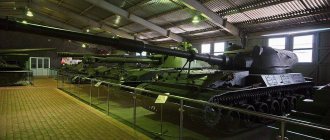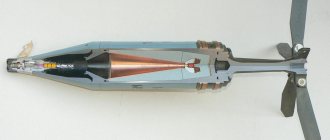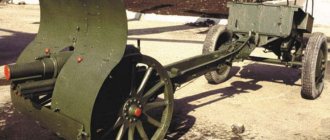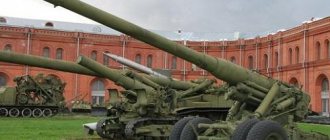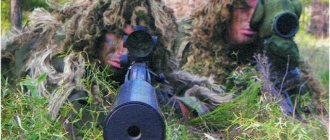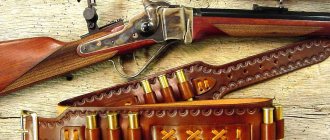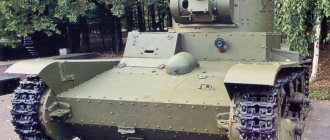Domestic tank guns. 125 mm smooth gun D-81
The appearance of the new English Chieftain tank and the American M60 tank made a great impression on the Soviet leadership. The 115-mm D-68 and U-5TS guns were not effective enough to fight these tanks, not to mention the D-10T2S gun. On June 15, 1961, the scientific and technical council of the State Committee on Defense Equipment made a recommendation to develop a smoothbore gun with an initial sabot projectile speed of 1800 meters per second and a direct shot range of 2100 meters. In July of the same year, the OKB-9 gun projects were reviewed. From the submitted projects, the project of the 125-mm smooth D-81 cannon was accepted.
Weight of the sub-caliber projectile – 5.7 kg; Pressure in the channel – 4000 kg/cm2; Initial speed – 1800 m/s; Direct shot range at targets 2 meters high – 2100 m; Armor penetration at a range of 2 thousand m – 350/150 mm (at meeting angles of 0°/30°); The mass of the cumulative projectile is 18 kg; Initial speed – 950 m/s; The armor penetration of a cumulative projectile along the normal line is 450 mm; Weight of high-explosive fragmentation projectile - 24.4 kg; Initial speed – 760 m/s; Firing range is about 10 thousand m.
It was decided to arm the Object 432 and T-62 tanks with the 125 mm D-81 cannon. At the end of the 61st - beginning of the 62nd year, there was a dispute about the type of loading of the D-81 cannon. A proposal was received from OKB-9 to use a separate-case loading system, and Kartsev, the chief designer of UVZ, demanded that the gun have unitary loading. A representative of NII-24 said that a unitary shot with a high-explosive fragmentation projectile will have a mass of about 40 kilograms. In addition, the use of unitary shots will entail a reduction in chamber volume and, consequently, a deterioration in ballistics. As a result, it was decided to use separate-case loading.
Serial model of the tank "Object 432" - Main battle tank T-64
A motorized rifle unit of the Soviet Army on a BMP-1 attacks with the support of T-62 tanks (photo from the Cabal archive, https://militaryphotos.net)
Work on the D-81 cannon was started by decision of the State Committee on Defense Equipment and the Ministry of Defense dated 07/11/62. It should be noted that the military did not really believe in smooth-bore guns, and in parallel with the 125-mm smooth-bore guns, the design of the rifled 122-mm D-83 gun was carried out. The technical specifications for the guns stated that the D-83 and D-81 should differ only in the barrel pipes and be interchangeable when installed in tanks. According to the project, the D-83 gun was supposed to have a sub-caliber projectile weighing 6.5 kilograms, an initial speed of 1610 meters per second and a pressure in the channel equal to 4000 kg/cm2. Loading of the smoothbore D-83 is separate-case. TsNII-173 developed a two-plane stabilizer for the D-83 and D-81 guns.
The recoil of the guns turned out to be so great that tracked carriages from high-power guns had to be used as firing ranges for them. In April 1963, OKB-9 transferred the D-81BL ballistic installation mounted on a carriage from a 203-mm B-4 howitzer to Pavlograd for a testing ground. In June of the same year, another ballistic installation D-83BL was transferred, mounted on the carriage of a 280-mm Br-5 mortar. In July, another ballistic installation was sent for installation in the Object 432 tank.
In April 1964, Plant No. 9 produced 5 prototypes of the D-81. These guns were sent in May: two - to the Kharkov Malyshev plant for installation in object 432; two - to the Nizhny Tagil Uralvagonzavod for installation in object 167 (a medium tank, which is a modification of the T-62 tank. Created jointly with ChTZ at plant No. 183 on an initiative basis as a gift to the XXII Congress of the CPSU. Tank weight - 36.7 tons, according to the project object 167 was supposed to be armed with a 115-mm U-5TS cannon with 40 rounds of ammunition. However, it was also planned to install a 125-mm D-81 cannon. The engine was a V-26 diesel engine with a power of 700 horsepower. The maximum speed on the highway was 65 km/h. Armor protection has been reduced compared to the T-62 tank: the side has been reduced to 70 mm from 80 mm; the lower frontal plate has been reduced to 80 mm from 100 mm; the rear has been reduced to 30 mm from 45 mm. Anti-radiation coating has been installed); one was left at plant number 9 for testing.
The first tank with an installed 125-mm cannon was delivered to NII-24 at the end of April 1964 to test shots.
During tests of the D-81 cannon, which took place in the first half of 1964, a single charge was selected for a high-explosive fragmentation and cumulative projectile. The direct shot range of a cumulative projectile is 1020 meters. Armor penetration at a meeting angle of 60° - 200 mm. The firing range of a high-explosive fragmentation projectile (design 6873) at an angle of 14° was 10.6 thousand m.
Firing with sub-caliber shells showed unsatisfactory results, especially in terms of accuracy. At a range of 2 thousand meters, the sub-caliber projectile at the limit penetrated 270 mm of armor along the normal line, and 150 mm of armor at an angle of 60°. The pressure in the barrel bore was 4620 kg/cm2, the initial speed of the sub-caliber projectile was 1800 m/s.
During firing from the 122-mm rifled D-83, it turned out that its armor penetration of the sub-caliber projectile was somewhat worse compared to the D-81. At the same time, the accuracy and range of a high-explosive fragmentation projectile is much better. The D-81 gun was assigned the GRAU index 2A26, the D-83 gun - 2A27. As a result, the D-81 smoothbore gun was chosen.
On May 20, 1968, a resolution of the Council of Ministers was issued on the installation of more powerful weapons in the T-64 (that is, the 125-mm D-81 cannon). It was decided to put it in the modification of object 432, which was called object 434. The new tank has been developed since 1962 at the UZTM design bureau. Object 434 went into serial production in 1969. In 73 tank object 434 was given the name T-64A.
T-64 in the museum of military equipment, Guryevsk, Kaliningrad region, Russia (photo by T. Dashina, https://technic-memorial.narod.ru)
T-72 first releases. Tankodrome KVTIU, late 1970s
The D-81 gun installed in the T-64A tank (object 434) was assigned the GRAU 2A26 index. The D-81 variant installed in the T-72 was assigned the index 2A26M2. The barrel consisted of a pipe, which in the chamber part was fastened with a casing, a coupling, a blowing mechanism and a screw-on breech.
Projectile – cumulative/high-explosive fragmentation; Initial speed – 930/845 meters per second; Channel pressure – 2370/2925 kg/cm2; Rollback length is about 300 mm.
The D-81 gun had a horizontal wedge breech with semi-automatic rolling mechanism. The knurl is hydropneumatic, the rollback brake is hydraulic. The knurling and recoil brake cylinders move with the barrel during a shot.
The gun had an electromechanical automatic loader with a constant loading angle and separate delivery of shot elements. The machine's capacity is 22 shots. One shot charges in 8 seconds. According to the “Service Manual” of the Ural tank, it takes 4-5 minutes to reload the loading mechanism conveyor with shots.
The D-81 gun was equipped with two-plane stabilizers of several types: 2E23, 2E26, 2E28M and others. The vertical guidance speed of the 2E28M stabilizer is 0.05 - 3.5 degrees per second, horizontal guidance - 0.07 - 6 degrees per second. It takes about 2 minutes to get ready for use, with continuous operation time of up to four hours. The average power consumption of the stabilizer is 3.5 kW.
During the war in Nagorno-Karabakh, several deficiencies in the loading mechanisms were identified on the T-72 (probably the same deficiencies would have been identified on the T-64 tanks, but they were not there). If the tank's roll was 25-30°, the loading mechanism failed. After firing the cannon, it was necessary to wait about a second and only then press the button to turn on the automatic loader. If this pause was not maintained, the machine gun would fail after several shots. Manual loading of the gun turned out to be very difficult, and this operation could only be carried out in a stationary tank.
The pipe walls of smoothbore tank guns were thinner and longer in length compared to rifled guns. Smooth pipes, compared to rifled ones, have significantly lower rigidity, as well as greater sensitivity when shooting to differences in temperature distortions that appear in the metal under the influence of rain, sunlight, and so on. As a result, curvature of the trunk occurs. Even the slightest curvature has a significant impact on the accuracy of fire. Firing errors of the 2A26M2, caused by thermal bending of the barrel under the influence of external conditions, could reach from 1.5 to 2.0 etc. Having received data on the use of thermal protective covers on NATO tank guns, our authorities decided to “dress” the D-81 guns in them .
The 2A26M2 recoil brake contained 400 milliliters of air to compensate for the thermal expansion of the liquid. This led to the formation of a liquid-air mixture in the rollback brake, which made the rollback uneven. Due to the unevenness of the rollback, errors arose in the accuracy of the fire, which exceeded the errors in the accuracy of the pointing of the gun system.
These shortcomings were eliminated in the modified D-81 model, which received the index 2A46M. The 2A46M smoothbore gun was equipped with a thermal protective casing, which reduced the effect of thermal bending, as well as a new design recoil brake, into which a fluid volume compensator was introduced. This improved the uniformity of recoil, and also reduced the resistance to recoil until the projectile left the bore.
Ballistics and ammunition of the 125-mm smoothbore D-81
All 125mm rounds are single-case loaded. The shot casings consist of a combustible body, which is pressed into a steel pan weighing 3.4 kilograms. Together with the D-81, the 4Zh40 cartridge case was adopted, and later the 4Zh63 cartridge case arrived. The differences between these sleeves were in the design and material of the case. The canvas in the 4Zh40 sleeve is pyroxypine-celluloid, impregnated with TNT (weight 4 grams), in 4Zh63 - high-nitrogen pyroxylin-celluloid, impregnated with TNT (weight 425 grams).
Data on armor penetration and ballistics are taken from various domestic and foreign advertising sources, so they may differ from the true ones.
Shots with sub-caliber armor-piercing projectiles consist of a cartridge case with a main combat charge and a arrow-shaped projectile with an additional propellant charge. The ZBM12, ZBM15 and ZBM22 sub-caliber projectiles have a tungsten (VN-8) core weighing 262-271 grams. Sub-caliber projectiles have a tracer, the burning time of which is 2-3 seconds.
Installation of the D-81 (2A26M2) cannon in the turret of the T-72 tank
Sub-caliber projectiles have an initial speed of 1715 m/s, however, according to some materials, the speed of these projectiles can be 1785 or 1800 meters per second. The range of a direct shot at a 2-meter target for the ZBM9 projectile is 2.1 thousand meters. The effective firing range of a sub-caliber projectile is from 1.5 to 2 thousand m.
The ZBK12 cumulative projectile has an initial speed of 905 m/s. Direct shot range - 960 meters. The tracer burn time is about 7 seconds. The armor penetration of the ZBK12M projectile at an angle of 60° is 220 mm.
125-mm separate-loading shots with cartridges with a combustible casing: Projectile type - sub-caliber; Projectile index – ZBM9; Shot index – ZBM10; Charge weight – 5 kg +3 kg additional charge; Projectile weight - 5.67 kg; Shot weight – 19.5 kg; The sleeve index is 4Zh40.
Projectile type – armor-piercing sub-caliber; Projectile index – ZBM12; Shot index – ZVBM6; Charge weight – 5 kg +3 kg additional charge; Projectile weight –5.8 kg; Shot weight – 19.7 kg; The sleeve index is 4Zh40.
Projectile type – armor-piercing sub-caliber; Projectile index – ZBM15; Shot index – ZVBM7; Charge weight – 5 kg +3 kg additional charge; Projectile weight - 5.9 kg; Shot weight – 19.7 kg; The sleeve index is 4Zh40.
Projectile type – armor-piercing sub-caliber; Projectile index – ZBM17; Shot index – ZVBM8; Charge weight – 5 kg +3 kg additional charge; Projectile weight – 6.09 kg; Shot weight – 19.7 kg; The sleeve index is 4Zh40.
Projectile type – armor-piercing sub-caliber; Projectile index – ZBM22; Shot index – ZVBM9; Charge weight – 5 kg +3 kg additional charge; Projectile weight – 7.0 kg; Shot weight – 20.2 kg; The sleeve index is 4Zh40.
Projectile type – armor-piercing sub-caliber; Projectile index – ZBM44; Shot index – ZVBM17; Projectile weight – 7.05 kg; Shot weight – 20.7 kg; The sleeve index is 4Zh63.
Type of projectile - cumulative; Projectile index – ZBK12M, ZBK12; Shot index – ZVBK7; Fuse - I-238; Charge weight – 5.0 kg; Projectile weight – 18.5 kg; Shot weight – 28.5 kg; The weight of the explosive in the projectile is 1.65 kg A-IX-1; The sleeve index is 4Zh40.
Type of projectile - cumulative; Projectile index – ZBK14M; Shot index – ZVBM10; Fuse - B-15; Charge weight – 19.08 kg; Projectile weight - 29.6 kg; The weight of the explosive in the projectile is 1.76 kg A-IX-1 or okfol; The sleeve index is 4Zh40.
Projectile type – high-explosive fragmentation; Projectile index – ZOF19; Shot index – ZVOF22; Fuse - B-429E; Charge weight – 5.0 kg; Projectile weight - 23.2 kg; Shot weight – 33.0 kg; The weight of the explosive in the projectile is 3.15 kg of TNT; The sleeve index is 4Zh40.
Projectile type – high-explosive fragmentation; Projectile index – ZOF26; Shot index – ZVOF36; Fuse - B-429E; Projectile weight – 23.0 kg; Shot weight – 32.5 kg; The weight of the explosive in the projectile is 3.4 kg A-IX-1; The sleeve index is 4Zh40.
As noted in the magazine “Military Parade” No. 1/97, the armor penetration of an anonymous cumulative projectile with an initial speed of 905 m/s along the normal is 500 mm, at an angle of 60° - 200 mm.
For a high-explosive fragmentation projectile, the reduced affected area is about 300 m2.
As the combat use of 125-mm high-explosive fragmentation shells has shown, they are quite effective. The effects of these shells on the White House in October 1993 are well known to everyone. Also, as an example, we can cite a case from the Karabakh war, when a T-72 fired a high-explosive fragmentation shell at a T-55 from 25 meters. The shell pierced the side armor and exploded inside the vehicle. Naturally, the T-55 could not be restored after this.
The armor thickness penetrated by the ZBM9 sub-caliber projectile at a range of 2 thousand m at an angle of 0° with the normal to the armor is 245 mm; 45° – 185 mm; 60° a – 140 mm. The ZBM15 projectile at an angle of 0° with the normal to the armor is 400 mm; 45° – 200 mm; 60° – 150 mm. In “Military Parade” No. 1/97 it was reported that the armor penetration of an anonymous projectile at an angle of 0° with the normal to the armor is 430 mm; 60° – 170 mm.
Data for 125 mm D-81 smoothbore guns, GRAU indices 2A26/2A46:
Caliber – 125 mm; Barrel length – 6350 mm (50.8 klb.)/6381 mm (51 klb.); Vertical guidance angle – from -5.5° to +14°/from -5° to +15°; The rollback length is normal – 270–320/270–325 mm; Maximum rollback length – 340/340 mm; Weight of sliding parts – 1850/1970 kg; Weight of the gun without stabilizer and armor – 2350/2443 kg Speed with automatic loading – 8 rounds per minute; Speed for manual loading is 1-2 rounds per minute.
Based on materials from an article by Alexander Shirokorad, “Equipment and Weapons” magazine
Tanks using 2A46[edit]
See also: T-72 operators and variants
Map showing 2A46 operators in blue with former operators in red
The 2A46 was used in a large number of tanks, almost exclusively Soviet/Russian designs or foreign derivatives:
- Bangladesh Type 59G (BD) Durjoy
- M-95 Degman
- T-72M4ChZ
- T-72SIM1
- Zulfiqar
- Tank Assad Babil
- Jungma-ho W (Ma)
- PT-91M Pendekar
- PT-91 Tvardi
- TR-125
- T-90
- M-84AS
- T-84
- M-84

